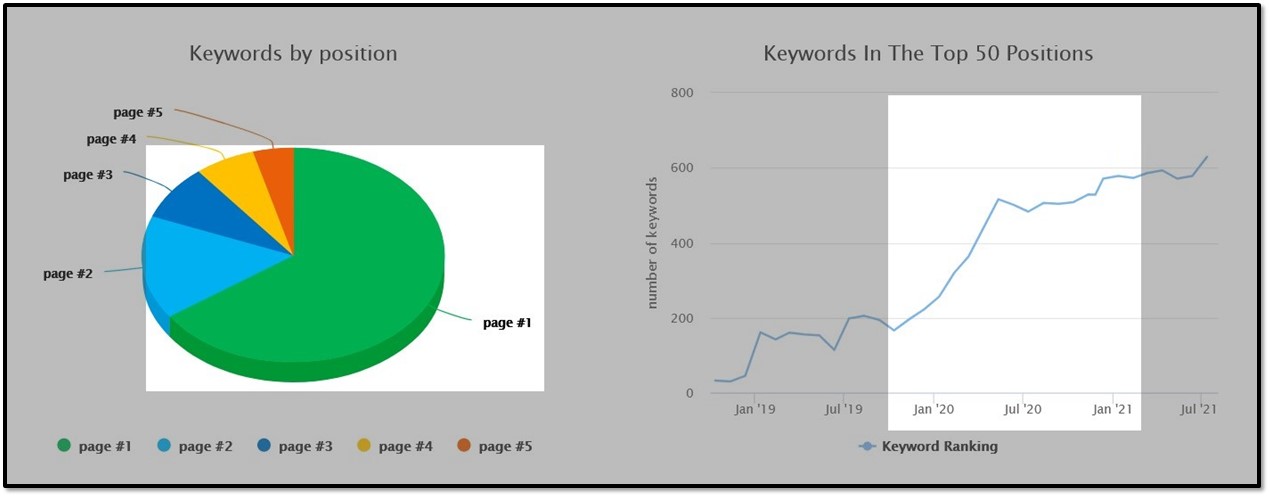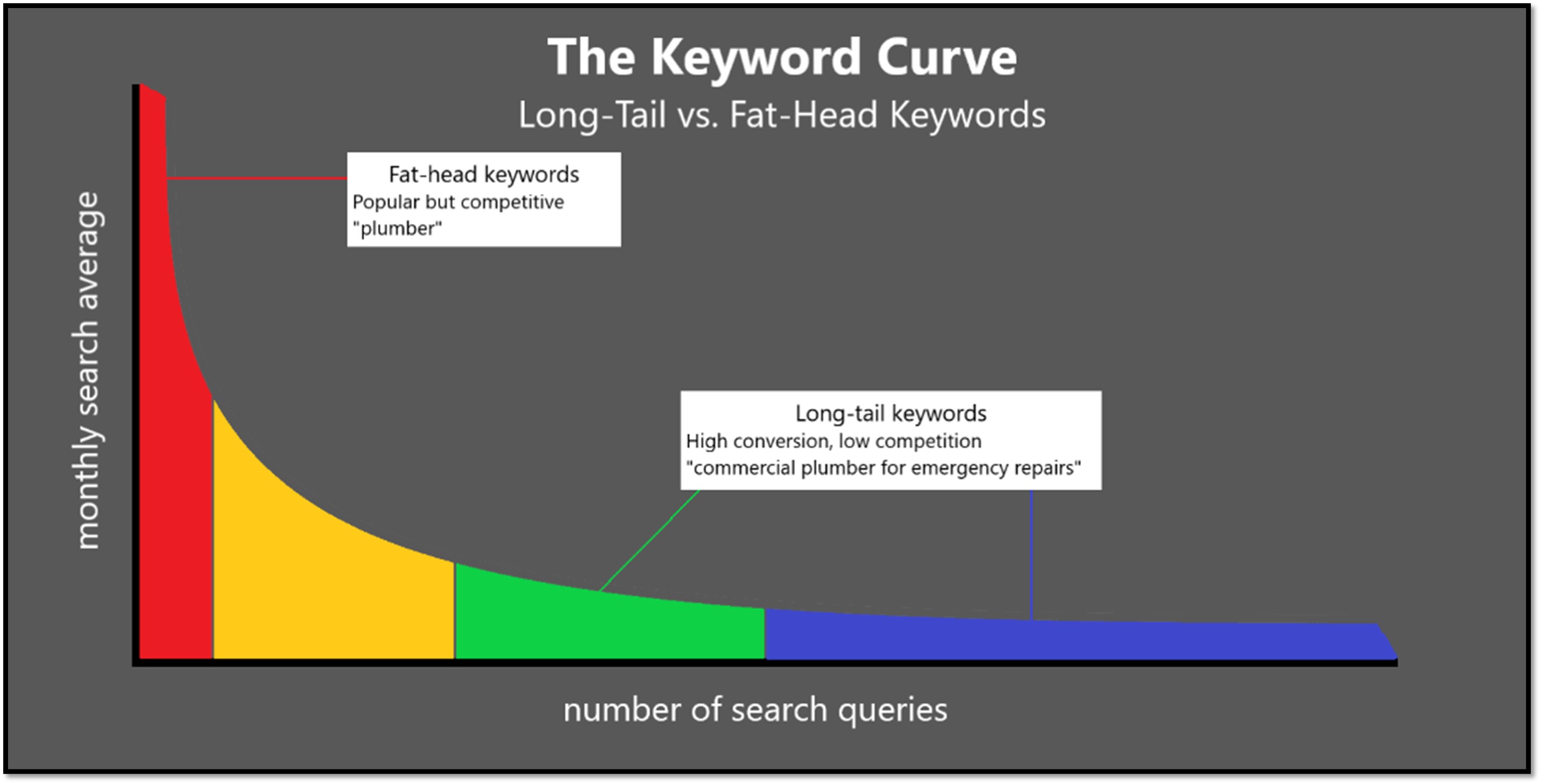
Forget about using short, generic keywords. The long-tail keyword (LT) is what you need to boost business.
In fact, long-tail keywords are what we use to supercharge our rankings and reach Google's front page.
They're also what we use to get our clients results like these:
Long-tails are a powerful, simple tool to improve your ranking on Google.
Let’s look at how you can use them to increase your online visibility and outrank your competition.
What Are Long-Tail Keywords?
At its simplest, a long-tail keyword is a longer-than-average keyword.
It strings together multiple terms to create a hyper-specific, ultra-focused keyword based on what users are searching for.
This is where the magic happens.
Long-tails home in on user search intent. Unlike short, "fat-head" keywords, a long-tail keyword focuses on a specific search query to address a user's unique need. That need could be an answer to a question, a service or product, or something else.
Whatever it is, long-tail keywords help you target that need directly.
Long-tail keywords tend to have low search volume, but high rewards. Compared to short keywords, a long-tail keyword won't have as many searches each month. But those who do search for it will be easier to target and convert. For that reason, long-tails usually have low competition, high rankings, and high conversions.
Long-tail keywords tend to be at least three words in length. That said, it's not really about the length—it’s about staying focused on the searcher’s intentions.
Why Use Long-Tail Keywords for SEO?
Let’s look at the facts:
92% of all search queries are long-tail keywords.
Those long-tail keywords include questions or commands like:
- Best burger restaurant in the city
- Compare flight prices from American Airlines and Delta Airlines
- Best place to watch a live band in the city
- Commercial plumber for emergency repair
What's more, 55% of today’s youth use voice search on their smartphones.
Unlike shorter keywords, long-tail keywords are naturally optimized for voice search. They replicate our natural speech patterns, allowing you to home in on that crucial contingent of users who rely on voice commands to conduct search queries.
When you understand the intent and nature of the phrases a person uses to make a query, you can better connect with them to put your business in front of their eyes.
An Example of Long-Tails Keywords' Importance
Let's say you're an online vendor who sells comical, seasonal T-shirts.
- T-Shirt has a monthly search volume of 301,000. (Fat-head keyword)
- Funny T-shirt has a monthly search volume of 60,500.
- Funny Christmas T-shirt has a monthly search volume of 14,800.
- Funny Christmas T-shirt for Adults has a monthly search volume of 30. (Long-tail keyword)
In this example, T-shirt clearly has the higher search volume, so why not target that as a keyword?
Remember search intent:
Sure, T-shirt has the highest search volume. But that only tells part of the story.
Hundreds of thousands of users are searching for T-shirt every month. But that T-shirt returns millions of results. When you try to rank for something generic like T-shirt, you're competing with those millions of pages already on Google, already ranking. That makes it extremely difficult to compete and hit the front page.
Plus, ranking for T-shirt may not be that lucrative. Thousands of users may search for T-shirt every month, but that doesn't mean they're all looking for the exact same thing. Some might be looking for fashion inspiration. Others might be looking for T-shirt styles and product reviews. Others still might be looking to buy a T-shirt.
A user who searches funny Christmas T-Shirts for adults, however, is looking for something much more specific and is much more likely to purchase said T-shirt. That user is communicating a clear intention to buy.
Fat-head keywords may let you cast a wide net. But it's no use if that net's going in an empty, overfished sea. By contrast, long-tail keywords let you cast that same net at an obvious mark. They give you a clear target with a big bullseye.
6 Reasons to Use Long-Tail Keywords
By now, you probably realize there are many benefits of using long-tail keywords in your content strategy.
Here are the 6 biggest advantages:
- Less competitive and more specific
- Less effort and expense to rank
- Amplifies your content visibility
- Gets new pages ranking faster
- Higher conversion rates
- Keeps you optimized for emerging search trends like voice queries
How to Find Long-Tail Keywords
The first step to finding long-tail keywords is to compile a list of keyword seeds.
To speed up this step, use a keyword generator like:
Once you’ve compiled your list of seeds, type each seed word into Google and check the auto complete section.
Look over the auto-complete results and grab the ones that best compliment your business. This is what we'll use to create our long-tail keywords.
Repeat these steps in any other search engine you’d like to optimize for, remembering to keep your lists separate so you know which to use for each platform.
How Do I Generate Content Based on Long-Tail Keywords?
The first question you need to ask yourself is, “How many long-tail keywords am I targeting, and how closely do these intertwine?
Generally, you should create a specific landing page targeting each keyword.
But if you have 100s of long-tails to target, and you can't find a way to differentiate all of them, you may not be able to create a dedicated landing page for each of them.
In such cases, you can add long-tail keywords to existing pages, inserting them as needed and where best suited to optimize your copy.
To do this, you’ll need to be organized.
Organizing Your Keywords
You can start by separating keywords by topic to give yourself an idea of which part of your site they will naturally integrate into.
When content related to these keys already exists within your site’s framework, it’s easy to pepper in long-tail keywords to optimize your copy. If there is no context for some of your LTs, you’ll know these are some of the words you’ll need to build on for the future.
Keep in mind: Your SEO strategy is not complete until you’ve included these gems.
Pro Tip: Internal links are a great place to incorporate long-tail keywords, so don’t forget about these!
Conclusion: Long-Tail Keywords Drive
Now that you understand the secret to finding and utilizing long-tail keywords, you have the ability to create high-conversion content that drives not only traffic, but sales and transactions.
Create content using long-tail keywords, and you're miles ahead of most of your competitors. Go long—because this tip promises to take you far.
Did these tips inspire you to mine for long-tail keyword gold? We’d like to hear about it in the comments below!
Looking for more web wizardry to boost business? As North America's leading small-business search engine specialist, LinkNow's here to help. Comment below, email website@linknowmedia.com, or call 888-667-7186 for a free consultation.



